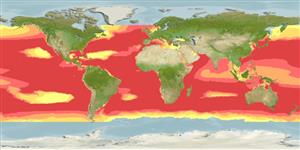Common names from other countries
>
Stomiiformes (Lightfishes and dragonfishes) >
Sternoptychidae (Marine hatchetfishes) > Sternoptychinae
Etymology: Argyropelecus: Greek, argyros = silvered, silver + Greek, pelekys = axe (Ref. 45335).
Environment: milieu / climate zone / depth range / distribution range
экология
морской батипелагический; пределы глубины 0 - 2400 m (Ref. 74511), usually 100 - 700 m (Ref. 28981). Deep-water; 60°N - 56°S
Eastern Atlantic: north of British Isles to South Africa, including western Mediterranean. Western Atlantic: New Jersey, USA to Argentina (Ref. 26340). Northwest Atlantic: Canada (Ref. 5951). Eastern Pacific: throughout the California Current area, seaward of the continental shelf (Ref. 35838). Known from tropical and subtropical waters of all oceans (Ref. 47377). South China Sea (Ref.74511).
Length at first maturity / Size / Вес / Возраст
Maturity: Lm ?, range 3 - ? cm
Max length : 5.1 cm TL самец/пол неопределен; (Ref. 96016); наибольший вес (опубликованные данные): 1.42 g (Ref. 128245); наибольший возраст (опубликованны данные): 1.00 годы (Ref. 5168)
Краткое описание
определительные ключи | морфология | морфометрия
колючие лучи спинного плавника (общее число) : 0; членистые (мягкие) лучи спинного плавника (общее число) : 8 - 9; колючие лучи анального плавника: 0; членистые (мягкие) лучи анального плавника: 11 - 12; позвонки: 36 - 39. Body bright silvery in color; body and trunk with dusky coloration at night (Ref. 4054). Branchiostegal rays: 10 (Ref. 35838).
Oceanic (Ref. 4739) and mesopelagic, mainly at 250-650 m (Ref. 4054). Depth range from 100-700 m (Ref. 4462) and from 460-1082 m in the eastern Ionian Sea (Ref. 56504). Adults make marked vertical migrations (Ref. 4739). Found singly or in small groups (Ref. 4739). An opportunistic feeder at dusk on calanoid copepods, small fishes, etc (Ref. 4739). Sexual dimorphism with regard to body size (Ref. 5168), the males being slightly smaller than the females (Ref. 8966). Oviparous, with planktonic eggs and larvae (Ref. 35838).
Occurs between 200 and 700 m depth during the day, concentrated between 350 and 550 m, and between 100 and 650 m at night, preferring a depth between 150 and 380 m Ref. 47377). Also Ref. 58302.
Spawns more than once per season with egg batches about 50-500 egg/ovary pair, the number increasing with increased animal size (Ref. 4739).
Gon, O., 1990. Sternoptychidae. p. 123-126. In O. Gon and P.C. Heemstra (eds.) Fishes of the Southern Ocean. J.L.B. Smith Institute of Ichthyology, Grahamstown, South Africa. (Ref. 5168)
Статус Красного Списка МСОП (Ref. 130435)
CITES (Ref. 128078)
Not Evaluated
Угроза для людей
Harmless
Использование человеком
рыболовство: интереса не представляет
дополнительная информация
инструменты
Специальные отчеты
Скачать в формате XML
ресурсы в Интернет
Estimates based on models
Preferred temperature (Ref.
115969): 5.5 - 21.3, mean 11.3 (based on 2694 cells).
Phylogenetic diversity index (Ref.
82804): PD
50 = 0.5078 [Uniqueness, from 0.5 = low to 2.0 = high].
Bayesian length-weight: a=0.01698 (0.00984 - 0.02932), b=3.11 (2.96 - 3.26), in cm Total Length, based on LWR estimates for this species & Genus-body shape (Ref.
93245).
Trophic level (Ref.
69278): 3.1 ±0.14 se; based on food items.
устойчивость к внешним воздействиям (Ref.
120179): высокий, минимальное время удвоения популяции до 15 месяцев (tm=1; tmax=1).
Fishing Vulnerability (Ref.
59153): Low vulnerability (10 of 100).
